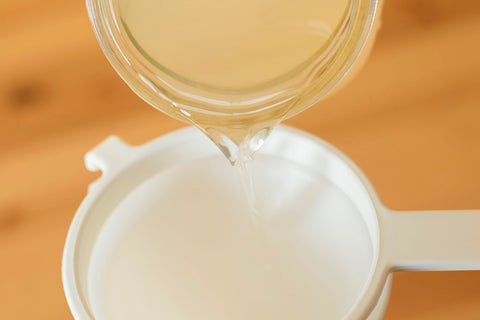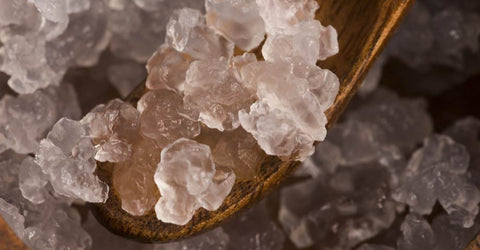
From where water kefir grains come from to how water kefir is made to what exactly is in that final bottle of water kefir, there are many misconceptions when it comes to a kefir drink.
To better understand the how and what of water kefir, let’s take a closer look at some facts about this fizzy fermented drink. We'll bust some common myths and show you just how easy it is to make a kefir drink at home!
Click to download our Water Kefir Guide and Recipe book today and debunk the 10 most common myths about water kefir drinks!
MYTH #1: WATER KEFIR & KOMBUCHA ARE THE SAME
It's true that water kefir and kombucha have much in common. They are both probiotic beverages. They both can be carbonated and flavored with various fruits and sugars through a second fermentation.
However these fermented drinks have several differences too!

The amount of time it takes to culture each drink is vastly different as are the microorganisms involved in culturing.
LEARN MORE: Composition of Water Kefir Grains
While both fermented drinks are great digestive aids, they each contain different levels of acids and bacteria.
LEARN MORE: What's in My Kombucha?
The flavors are quite different, too. Kombucha has a tart zing, while water kefir is sweeter in flavor. Even after a second fermentation, many prefer to drink one over the other.
You can learn more about their differences in Water Kefir vs. Kombucha.
MYTH #2: WATER KEFIR CONTAINS A LOT OF SUGAR
Like kombucha and milk kefir, water kefir’s final sugar content is dependent upon how long you allow it to culture. As it cultures, the grains consume the sugars and convert them to carbon dioxide (carbonation), acids, bacteria, and yeasts.

If you are trying to avoid sugar, allow your kefir drink to ferment until it is just a little bit sweet on the first fermentation. When bottled, it will still have enough sugar, with the addition of fruit or fruit juice, for carbonation but will have a lower sugar content once the second fermentation is complete.
Using water kefir grains to culture coconut water is another way to create a probiotic drink with less sugar. Just make sure you alternate between culturing in sugar water and coconut water to keep your grains healthy!
SEE INSTRUCTIONS: How to Make Coconut Water Kefir
MYTH #3: WATER KEFIR CONTAINS A LOT OF ALCOHOL
It is true that alcohol is a by-product of fermentation, even for lactic acid-based ferments like milk kefir and kombucha. Water kefir is no different.
Because water kefir does not contain as much acetic acid as kombucha, its flavor does not have as much of a tangy punch. Any alcohol present is therefore slightly more noticeable in water kefir since it is not masked by the tangy zip that is present in kombucha.
With that said, the amount of alcohol in the final ferment of a kefir drink from our culture kifer is so little, it is practically non-existent.

MYTH #4: WATER KEFIR CAN BE MADE WITHOUT WATER KEFIR GRAINS
There are many beverages on the market - and many recipes on the internet - for probiotic bubbly beverages. These are sometimes marketed as “water kefir” or are confused as water kefir because they are homemade enzyme-rich sodas.
While they may share health properties and attributes with water kefir, these drinks are not truly water kefir unless they were made with real Water Kefir Grains. The yeast and bacteria strains found in the water kefir culture are unique and the flavor is inimitable.

MYTH #5: YOU CAN MAKE WATER KEFIR GRAINS FROM SCRATCH
A common question from DIYers is “Can I make water kefir grains from scratch?”
Unfortunately, the short answer to this is no.

The long answer is that the specific microorganisms and polysaccharides that come together to form a mother culture such as water kefir grains are not something you can simply make from ingredients.
LEARN MORE: Composition of Water Kefir Grains
If water kefir grains are given the proper food and environment they can multiply as they culture. However, the grains themselves cannot be made from cultured water kefir liquid or anything else.
You must, therefore, acquire water kefir grains from a friend or reputable source.
MYTH #6: YOU MUST USE A SPECIFIC SUGAR TO MAKE WATER KEFIR
While it is true that certain sugars are better for water kefir grains than others, there are several sugars that will work for making water kefir.
What are your options?

Granulated cane sugar – sometimes known as table sugar - does work well, though it does not contain much in the way of minerals, which are important for keeping water kefir grains healthy. Luckily, combining cane sugar with molasses, sucanat, or coconut sugar solves this dilemma.
Sucanat, also known as rapadura, can also be used to make water kefir, and will produce a strong-flavored kefir drink.
As far as coconut sugar, since its mineral content is so high, we recommend using only small amounts in combination with cane sugar.
LEARN MORE: Choosing Sugar for Water Kefir
MYTH #7: WATER KEFIR GRAINS & MILK KEFIR GRAINS CAN BE USED INTERCHANGEABLY
The specific strains of microorganisms in milk kefir grains and water kefir grains are unique to each. It is therefore not possible to exchange one for the other directly or to simply use extra grains of either culture to ferment the other medium.
There have been attempts to convert milk kefir grains to water kefir grains, though the results are consistently not very successful.

There are, however, two ways in which milk kefir grains and water kefir grains can be used similarly.
- Extra milk kefir grains can be used to culture fruit juice and sugar water. The grains must be rinsed very thoroughly and, unless you consider them disposable, should be refreshed with dairy milk after the 12-24 hour sweetened water culturing period.
- Cultured water kefir itself can be used to culture non-dairy milks, as noted above, though the grains themselves are generally not used for this purpose.
MYTH #8: MY WATER KEFIR GRAINS ARE NOT MULTIPLYING, THEREFORE THEY ARE NOT WORKING
We frequently are contacted by customers concerned that their water kefir grains have stopped working because they don't see them multiplying.
It is true that the multiplication of a culture such as water kefir or milk kefir grains is indicative of a robust, thriving culture.

However, It is not necessarily true that the multiplication of the mother culture is necessary for culturing to take place. If you are itching for your grains to multiply, there are some things you can do to nurture their growth.
LEARN MORE: Encouraging Water Kefir Grains to Multiply
MYTH #9: WATER KEFIR GRAINS NEED DRIED FRUIT OR LEMONS
Many online recipes for water kefir call for adding dried fruits, fresh ginger, or lemons. Other recipes state you must not add any of these, for the health of the water kefir grains.
So, which is it?
These items are most often added to give water kefir grains one of their favorite things – minerals. (If these are added, they must be unsulphured and organic to prevent damaging the water kefir grains.)
These additions aren’t necessary, however, because minerals can be provided to the water kefir grains through simpler means.

How?
Using a mineral-rich sugar, adding a bit of molasses, dropping in some minerals, or using half white sugar/half unrefined sugar, or 1-2 tbsps. of coconut sugar with the rest of your white sugar will give the water kefir grains all they need to thrive.
LEARN MORE: Choosing Ingredients for Making Water Kefir
MYTH #10: WATER KEFIR IS ONLY FOR DRINKING
While the most common way to enjoy water kefir is as a delicious carbonated beverage, its uses go beyond the simple bottle. The water kefir beverage can be used to culture both grains and non-dairy milks.
Fermenting Grains
A tablespoon of water kefir added to soaking water will ferment whole grains in 12-24 hours.
Water Kefir as Sourdough Starter
Replacing half of the liquid in a bread recipe with water kefir and cutting back the yeast by 50% will lengthen the rising time of a bread recipe and allow the water kefir to ferment the flour, much like a sourdough starter.

Make Coconut Milk Kefir
Finally, water kefir is commonly used to ferment coconut milk to make coconut milk kefir.
Making non-dairy milk kefir can get a bit tricky for those who are truly dairy-intolerant, especially when keeping milk kefir grains in dairy milk may not be an option.
By adding ¼ cup of water kefir to two cups of coconut milk you can culture non-dairy milk in 12-18 hours to create a truly dairy-free kefir drink!
SEE RECIPE: Coconut Milk Kefir
WHAT'S NEXT?
With these common misconceptions about water kefir set straight, you're in good shape to start making it at home.
Now it's time to get started making your own kefir drink and the best way to do this is with Cultures for Health.
We have the largest selection of kefir drink products including starter kits, bundles, and individual starter cultures. On top of that, we have all of the tools you'll need and in-depth instructions on exactly how to start making a kefir drink at home!
Check out our best-selling kits below to get started on your kefir drink making journey!
















